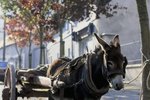Your horses may live in a cozy barn with three squares a day, but they still share many innate traits with their wild relatives. A gelding may not display mating urges, but most domesticated mares and stallions will. Understanding the wild horse lends clarity to mating behaviors, and can reassure you that some seemingly aggressive or odd conduct has purpose or meaning, rooted in years of survival instincts. For the owner with multiple horses, the intricacies of dominance and hierarchy may finally make sense when put into the context of sex and survival.
Herd Hierarchy
Harems aren’t just for exotic princes -- in the wild, a herd consisting of at least one stallion, and several mares and offspring, is a harem group. A dominate stallion leads the herd and is responsible for the herd's safety. He may tolerate other stallions that remain subordinate to him. Once he establishes dominance, the stallion banishes any stallions and mares he deems incompatible. The banished stallions find mares to form their own herd, although some may return to challenge the stallion and any other subordinate stallions in that herd who attempt to take over that leadership position. If another herd comes near, the stallion "snakes" around his herd -- head down, in a threat position -- to keep their attention away from possible herd competition.
Breeding Behaviors
While the domestic mare exhibits the same breeding behaviors as her feral counterparts, most horse breeders don’t breed mares at as young an age as might occur in a wild herd. In that environment, a stallion might try to breed a young mare when she hits puberty at 12 to 15 months, but she is unlikely to have a successful pregnancy for another year or two.
Lengthening daylight triggers the mare’s estrus, or heat, cycles. If she’s a typical mare, she’ll cycle every 21 days, with each estrus lasting about six days. This continues throughout the spring and summer until she is pregnant, and some mares cycle year round. The mare has about three days of intense estrus when she is most receptive to a stallion. During this time, any stallion -- and many times geldings -- in her vicinity will curl his upper lip in a “smile” in what is known as the Flehman response.
The dominant stallion will court her by smelling, nuzzling and biting her. He will then nudge her to check her breeding stance readiness before mounting her. A mare and stallion in a herd will typically stay close to one another, repeating copulation periodically until the mare’s estrus ends. Subordinate stallions remaining in the herd may breed the younger mares, but most of the breeding is done by the boss stallion.
Herd Dynamics
A mare is extremely protective after giving birth -- to the point of threatening the stallion if he approaches the baby. But by the time the foal is 2 to 3 months old, she gives him increasing responsibility to find his way back to the herd on his own if he gets separated. As this happens, the stallion takes over, herding the wayward foals back to the group if they stray and teaching young males how to spar.
By sexual maturity, though, the young boys need to leave the herd so they won’t challenge their daddy for dominance. Moreover, the stallion’s female offspring also typically leave, since most stallions aren’t interested in breeding with their own female offspring. These youngsters typically leave by age 2. While that seems harsh, strong bonds are important to herd safety, and the stallion’s ability to have sex within the harem plays an important role in that bond.
Herd Predators
Safety in numbers is well demonstrated in the wild horse herd, particularly for the youngsters. One threat is from predators; depending on location, wild horses count wolves, hyenas, feral dogs and coyotes among potential menaces. Mom, dad and other herd adults all protect the babies from predators, sometimes creating a circle around the babies and kicking approaching predators with their hind feet. This collective effort keeps the foals safer than you might think.
References
- eXtension: Horse Breeding Behavior
- HorseChannel.com: The Birds and the Bees, the Stallions and the Mares
- University of Pennsylvania, Veterinary Medicine: Reproductive Behavior of the Stallion, Sue McDonnell, Ph.D.
- The Domestic Horse: The Origins, Development and Management of its Behaviour. D S. Mills, S. M McDonnell
Resources
Photo Credits
-
mari_art/iStock/Getty Images
Writer Bio
Based in Central Texas, Karen S. Johnson is a marketing professional with more than 30 years' experience and specializes in business and equestrian topics. Her articles have appeared in several trade and business publications such as the Houston Chronicle. Johnson also co-authored a series of communications publications for the U.S. Agency for International Development. She holds a Bachelor of Science in speech from UT-Austin.




